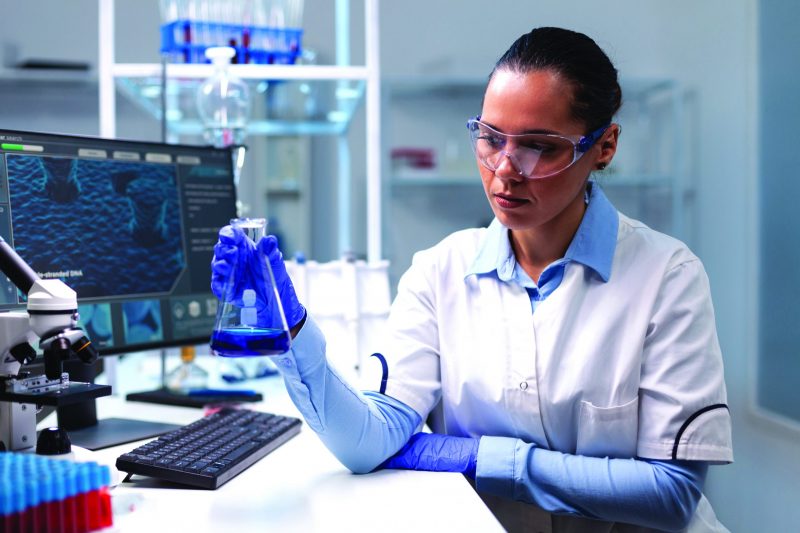Those who havent graduated from medical college but still want to be associated with medicine have several options. One of them is pathology.
Until as recently as 20 years ago, it was the physician who prescribed a few tests on the basis of his diagnosis. Today the world over, particularly in the advanced countries, a self-respecting physician is unlikely to entertain a patient unless he/she is armed with a battery of sophisticated test reports by a qualified pathologist.
The new generation pathologist does a lot more than just take blood and urine samples. He/she is required to do constant research, suggest new diagnostic tests using sophisticated new technologies.
Pathology literally means the study of disease. As such it is an indispensable science and medical specialisation. As a preface to concepts such as disease processes, tissue reaction, and injury, it is a cardinal subject necessary in the education of all medical practitioners. The numerous specialisations of medicine have their own needs, advantages, and disadvantages. Those who have not graduated from medical college but still want to be associated with medicine have several options. One of them is pathology.
All pathology clinics are either affiliated to hospitals or are independent entities. The lab is usually headed by a doctor with an MD degree in pathology i.e an individual who has specialised in pathology after qualifying as a medical practitioner. In the hierarchy below him are the senior and junior scientific officers, who either have M.Sc or Ph D qualifications, preferably in biochemistry, microbiology, or molecular biology. On the next rung are the technicians usually with a B.Sc degree plus a diploma in medical technology, with a minimum of six months to a years training in a lab. Finally, there are the lab attendants. A diploma in medical technology is offered by several universities and private sector education institutions. Mumbais SNDT Womens University is the best, offering a comprehensive three-year diploma course. A medical degree with specialisation in pathology is available in most medical colleges.
A qualified pathologist can either join a lab, a hospital, or teach. A teacher with a minimum of five years teaching experience can also guide M.Sc, MBBS and Ph D students.
EXPENSIVE EQUIPMENT. After some years of experience one can open ones own lab. For this, of course, you need deep pockets to invest in expensive equipment. A blood bank needs a licence from the Food and Drug Administration (FDA) and can be managed only by a pathologist with an MD degree. Jobs in pharmaceutical companies, research labs, consultancies, or as technical sales representatives can also be found if one has a B.Sc in microbiology, biochemistry, or molecular biology.
Another new area of interest for those trained in clinical pathology in recent years has been to apply managerial and medical/bioscience skills acquired during clinical training to opening up career opportunities in the corporate sector. This is a good qualification for a managerial position in an upstart biotechnology company as also for executive positions in larger healthcare delivery, diagnostic devices, R&D, or pharmaceutical firms.
Yet another career path for qualified clinical pathologists that has become popular is in medical informatics. The explosion of medical information in general, complex interactions involved in the interpretation of laboratory tests in patients on multiple medications including biologicals and the growing need for improved image analysis processing has made this an area with a great need for more physician-scientists applying their skills.
The pay scales in private, autonomous labs are modest compared with private and government hospitals. Technicians can expect pay packages ranging from Rs.10,000–20,000 per month. For senior scientists the pay ranges between Rs.20,000–30,000 depending on experience. While an MD can expect a starting package of over Rs.50,000 per month.
There have been amazing innovations in clinical pathology. With the invention of auto analysers many new tests can be performed. When I started out 40 years ago in the pathology department of Bombay Hospital, all testing was done manually using logarithm tables and slide rules. We even had an animal house in Bombay Hospital for stocking sheep, guinea pigs, and rabbits which were used for testing the presence of tubercular bacilli and for pregnancy tests. Now with the kind of equipment we have we can conduct complicated tests at the click of the mouse,” says Dr. Praful B. Amin (68), founder and consulting pathologist at Mumbais sophisticated and fully computerised Dr. Amins Pathology Laboratory.
I wanted to be an engineer but chose pathology as my father was a pathologist and insisted on my following in his footsteps. In 1966, I passed my MD in clinical pathology from G.S. Medical College. I started my career in Bombay Hospital as a helping hand to my father who headed the pathology department there. After a few years, when innovations in pathology started, I went to the US for a 30-month study programme. I specialised in cytology, took training in pathology automation, and was for one year with the famous Johns Hopkins Hospital in Baltimore,” recalls Amin.
After returning from the US, Amin set up the first automation machine SMA-12 in Bombay Hospital. Soon after we had differences with the management on automation and in 1979 my father, brother and I started our fully computerised independent lab in clinical pathology. My father died in 1982 and my brother left for the US. So I was left alone to manage this lab,” he reminisces.
Amin believes that the pathology function has become increasingly important in contemporary medicine. Im doing over 200 tests in my lab as with the auto analyser the capacity has increased. In one hour an SM2 machine can perform 720 tests. Today huge throughput capacity is available to a pathologist. Moreover, with the rapid strides in technology, technical errors are minimal and weve almost wholly eliminated human error in our lab,” says Amin.
